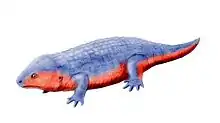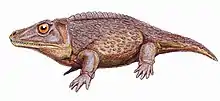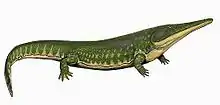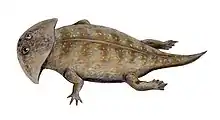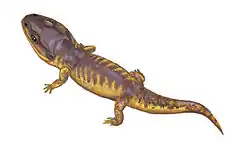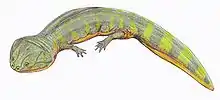Blinasaurus
Blinasaurus is a name of an extinct genus of prehistoric brachyopid found in Triassic geological formations of Australia. The type species is Platyceps wilkinsonii Stephens, 1877.[1] The genus was established by John W. Cosgriff in 1969 to incorporate the type, discovered in New South Wales, and the author's new fossil species, Blinasaurus henwoodi, describing type material found in Blina Shale in the Kimberley region of northwest Australia.[2]
| Blinasaurus | |
|---|---|
| Scientific classification | |
| Kingdom: | Animalia |
| Phylum: | Chordata |
| Order: | †Temnospondyli |
| Suborder: | †Stereospondyli |
| Family: | †Brachyopidae |
| Genus: | †Blinasaurus Cosgriff, 1969 |
The genus was represented by three species,[3] however, the type species (Platyceps wilkinsii Stephens, 1877) was assigned to a new monotypic genus as Platycepsion wilkinsoni. A species described by Cosgriff in the same study was placed in a new combination as Batrachosuchus henwoodi.[4]
References
- Stephens, W.J. (1887). "On some additional labyrinthodont fossils from the Hawkesbury sandstones of New South Wales. (Platyceps Wilkinsonii, and two unnamed specimens.)". Proceedings of the Linnean Society of New South Wales. 1: 1175–1192.
- Cosgriff, J.W. (1969). "Blinasaurus, a brachyopid genus from Western Australia and New South Wales". Journal of the Royal Society of Western Australia. The Society. 52 (3): 65–90.
- Vickers-Rich, P. (1991). Vertebrate palaeontology of Australasia /. Melbourne: Monash University Publications. p. 576. ISBN 9780909674366.
- Warren, Anne; Marsicano, Claudia (17 April 2000). "Banksiops, a replacement name for Banksia townrowi (Amphibia, Temnospondyli)". Journal of Vertebrate Paleontology. 20 (1): 186. doi:10.1671/0272-4634(2000)020[0186:BARNFB]2.0.CO;2.
This article is issued from Wikipedia. The text is licensed under Creative Commons - Attribution - Sharealike. Additional terms may apply for the media files.



